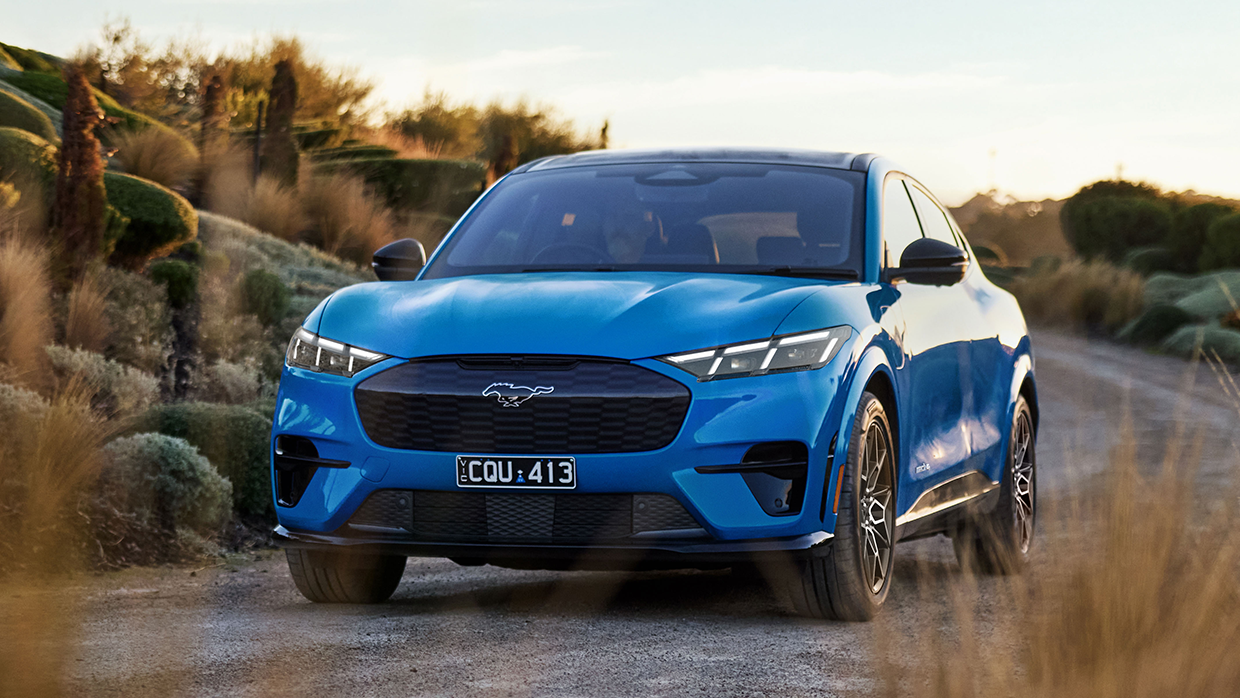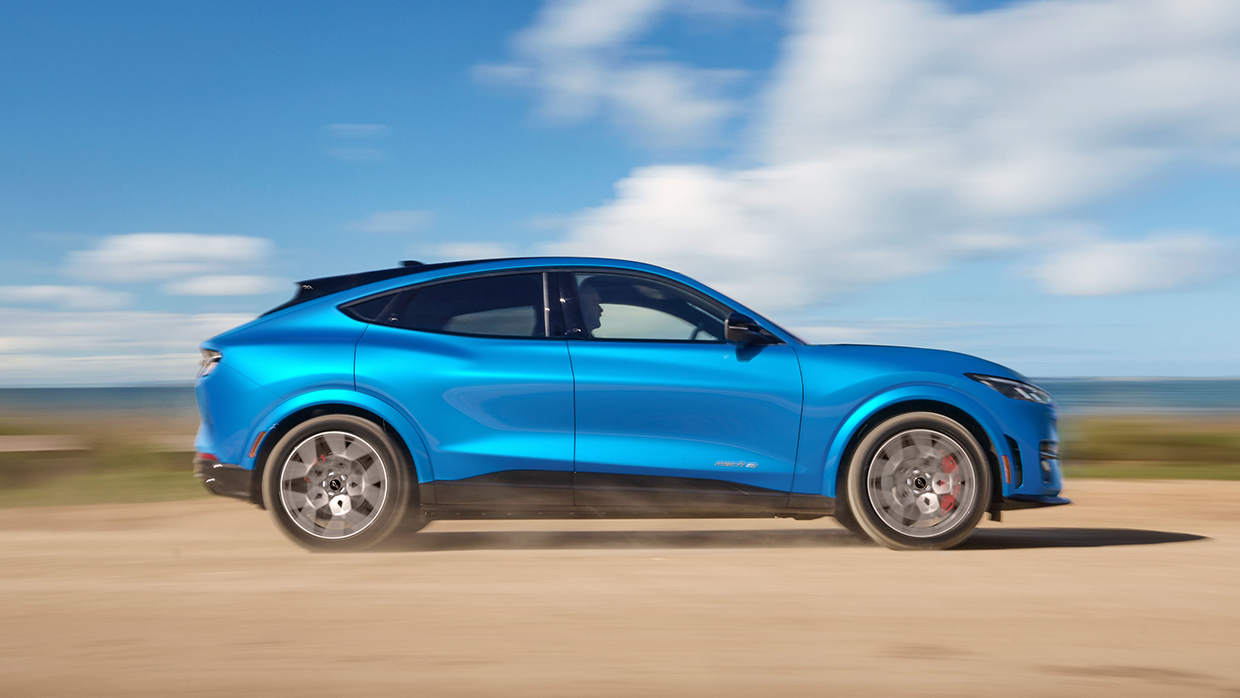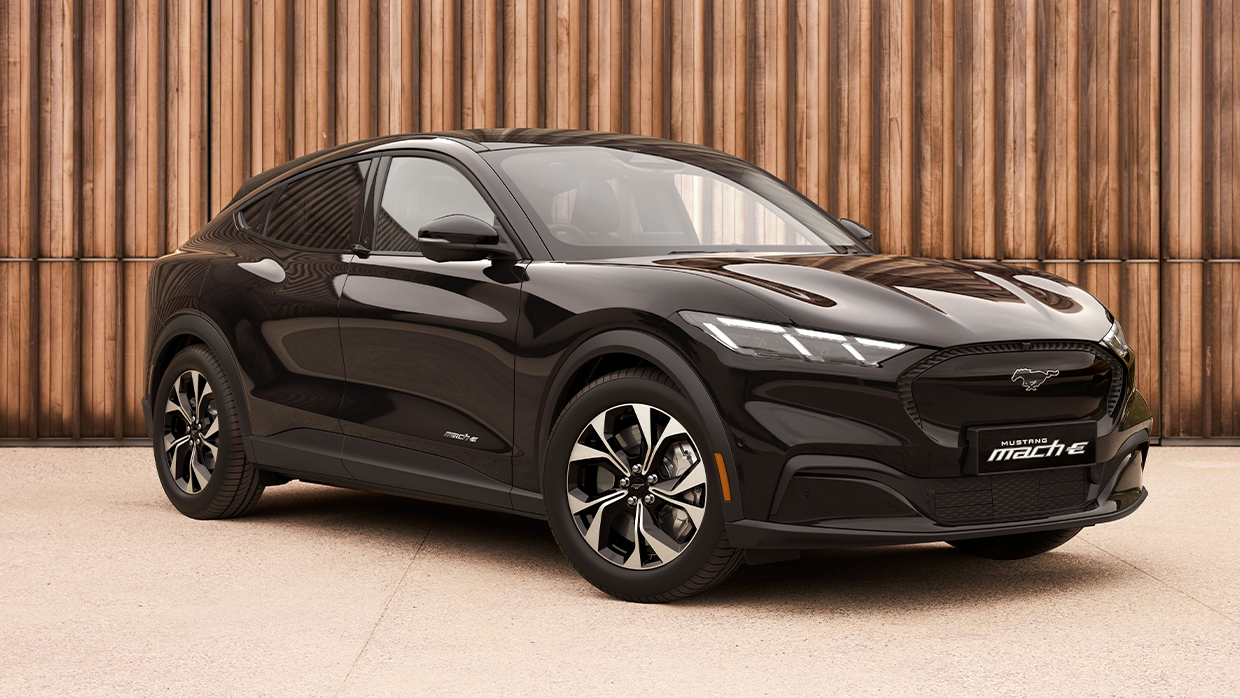Ford Mustang Mach-E 2026: midsize rival to the Tesla Model Y and BYD Sealion 7 to receive a midlife facelift
1 week ago
Lukas Foyle
Contributor
String of updates coming to Ford Oz’s sole non-commercial EV, with pricing to remain largely unchanged
Ford Australia has confirmed a range of minor cosmetic upgrades for its Mustang Mach-E alongside power and efficiency improvements to its dedicated EV drivetrain.
Pricing of the Mustang Mach-E is set to remain largely unchanged for the Q4 2025 update, now starting from $65,990 for base Select models (up $1000), $80,490 for midrange Premium grades, and topping out at $98,490 for range topping GT variants (both up $500).
Prices shown for above grades are before on-road costs.

Closest rivals to the Mustang Mach-E include the EV segment leading Tesla Model Y, from $58,900, and popular newcomer BYD Sealion 7, from $54,990. Both before on-roads.
Hyundai’s Ioniq 5 is another close rival to the Mustang Mach-E. That car now starts from $65,990 drive-away on offer as part of an EV price reduction onslaught undertaken by the Korean automaker.
Headlining the 2026 Mach-E facelift are two notable performance enhancements, which apply to both the entry-level Select and range topping GT grade.

The Mustang Mach-E Select will gain a 14kW and 95Nm kick, now outputting peaks of 212kW/525Nm from its single electric motor and unchanged 73kWh (usable) battery. This peak output will be shared by the Mach-E Premium, up from 216kW/430Nm.
The Select range figure also improves, now 470km combined, tested to WLTP standards. The Premium’s range is unchanged at 600km, as is its 88kWh battery.
The MY26 Mach-E GT will become Ford Oz’s most powerful EV to date, set to output 434kW/955Nm to all four wheels — up 21.2 and 11.0 percent, from 358kW/860Nm.

The updates for the MY26 GT come just in time to contend with Tesla’s 461kW/741Nm Model Y Performance, which starts at $89,400 before on-road costs, as well as the Hyundai Ioniq 5 N, which starts from $110,383 before on-roads and produces 478kW/770Nm (N Grin Boost figure shown).
The GT’s range figure also improves, now quoted as 515km WLTP. Both the Mach-E GT and Premium also benefit from reduced rapid DC charge times, now replenishing 10-80 percent of battery in 36 minutes, peaking at 150kW DC.
All Mustang Mach-E models will additionally benefit from a new heat pump, which improves powertrain thermal efficiency, alongside new alloy wheel designs.


Inside, all models receive 10-way power adjustable front seats (up from eight-way), and a new column shifter which replaces the outgoing rotary dial gear selector. The new gear selector provides more space within the cabin, says Ford.
Select and Premium models gain a revised suspension geometry, with new sway bars, springs, and dampers. Ford claims the revisions will provide a more comfortable ride without losing a “sporty feel”.

Other minor model specific upgrades for MY26 include:
- Standard equipment projector headlights slated for the base Select to match those seen in the Premium and GT
- Matte black enhancements to lower portions of front, rear and side panels for Premium models, as well as colour-matched wheel arches replacing outgoing gloss black
- New grille design for GT
Ford has additionally revealed six new colourways for the MY26 Mach-E, available at a $700 premium over standard Shadow Black and Star White.

The new colours are: Velocity Blue, Molten Magenta, Glacier Grey, Grabber Yellow, Terrain, and Eruption Green.
GWM Tank 500: New 3.0-litre diesel engine to debut in Australia in 2026 to fight Toyota Prado, Ford Everst and Isuzu MU-X
1 week ago

GWM set to ratchet up the fight with Toyota with big new diesel set to be added to Tank 500 alongside emissions-friendly plug-in power
A larger-displacement four-cylinder turbo diesel engine in development by GWM will have its global debut in Australia “by mid-2026”, the conglomerate’s chief technology officer Nicole Wu says.
“A three-litre turbo [engine] is coming soon, and here is the kicker — our 3.0-litre Tank diesel model will make its global debut right here in Australia by mid next year,” Wu told media including Chasing Cars.

The decision to unveil the new engine in Australia is a boon for GWM’s local operations, with GWM global executives confirming Australia is a pillar of the Chinese conglomerate’s expansion strategy.
GWM is rapidly expanding powertrain options in Australia, with the all-new diesel joining a lineup that also includes petrol engines, plugless petrol hybrids (HEVs), plug-in hybrids (PHEVs), and battery EVs (BEVs).
While most brands are moving away from diesel engines, GWM says the expanding share of hybrid sales will create headroom under Australia’s New Vehicle Efficiency Standard (NVES) regime to continue selling diesel and petrol engines in future.
3.0-litre diesel to be sold alongside plug-in hybrid engines
The new 3.0-litre four-cylinder diesel engine will make its debut in the Tank 500 four-wheel drive, with the engine set to become GWM’s ‘premium’ diesel powertrain.

Meanwhile, a 2.4-litre diesel engine producing 135kW/480Nm is expected to continue doing duty in smaller GWM 4WD models including the Tank 300 and the standard-size Cannon ute.
“We know Aussies love diesel, and we have been perfecting it since 2002 with 24 years of know-how,” said Wu.
The Tank 500, a Toyota LandCruiser Prado rival, is currently offered in Australia with a 255kW/548Nm 2.0-litre turbo petrol/hybrid (HEV) engine, with a 300kW/750Nm 2.0-litre turbo petrol/plug-in hybrid (PHEV) option joining the line-up imminently.

GWM will rely on sales of the Tank 500 PHEV to balance out the model’s average emissions, though it expects the 3.0-litre diesel to sell very strongly in Australia — potentially necessitating the diesel to be more expensive than the PHEV over time.
Initially, however, GWM chief operating officer John Kett told Chasing Cars that the plan is to “let [the 3.0-litre diesel] run” before making any powertrain pricing adjustments to suit NVES requirements over time.
Both the PHEV and the new diesel are expected to generate considerable additional sales for the Tank 500, as sales performance with the HEV-only powertrain lineup has lagged well behind the Prado.
New diesel also expected for Cannon Alpha, V8 still in development
The large Cannon Alpha ute is also likely to receive the 3.0-litre diesel engine, where it will be sold alongside the existing PHEV version of the Cannon Alpha.

Performance of the new diesel engine is expected to be higher than the existing 2.4-litre’s 135kW/480Nm outputs, while also reducing fuel economy and CO2 emissions. In the Tank 300, the 2.4-litre consumes 7.8L/100km in ADR combined testing.
While the 3.0-litre engine is likely to be the largest capacity diesel GWM will offer for the foreseeable future, development work continues on a 4.0-litre petrol V8 powertrain that is under consideration for Australia.
The V8 may be teamed with a hybrid system to make its emissions more manageable, and GWM has foreshadowed a “military-grade” super off-road model will be revealed soon. That 4WD may be the debut platform for the V8 engine.

Under NVES, carmakers that sell too many high-CO2 vehicles (such as pure diesel and petrol models) are penalised — but NVES penalties can be balanced out with credits effectively generated by the sale of EVs and PHEVs.
“GWM is well positioned not just to cope with but to thrive in this new era,” said GWM Australia head of marketing Steve Maciver.
GWM’s sales of PHEV models under its Haval, Tank and Cannon lineups, as well as BEVs under the Ora brand, are expected to put it into NVES credit territory.



